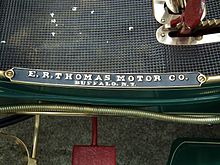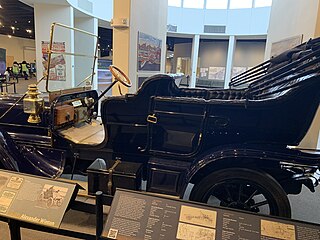
The Winton Motor Carriage Company was a pioneer United States automobile manufacturer based in Cleveland, Ohio. Winton was one of the first American companies to sell a motor car. In 1912 Winton became one of the first American manufacturers of diesel engines.
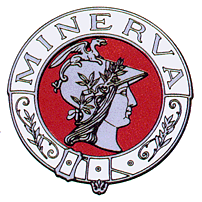
Minerva was a Belgian firm active from 1902 to 1938 which was a prominent manufacturer of luxury automobiles. The company became defunct in 1956.

The Acme was a make of American automobiles made in Reading, Pennsylvania from 1903 to 1911. They were the successor of the Reber which was made from 1902 to 1903 by Reber Manufacturing.

L'Aster, Aster, Ateliers de Construction Mecanique l'Aster, was a French manufacturer of automobiles and the leading supplier of engines to other manufacturers from the late 1890s until circa 1910/12. Although primarily known as an engine mass manufacturer the company also produced chassis for coach-works and a complete range of components.

Elmore Manufacturing Company was a manufacturer of veteran and brass era automobiles and bicycles (1893–97), headquartered at 504 Amanda Street, Clyde, Ohio, from 1893 until 1912. The company took its name from a small parcel of land in Clyde with the name Elmore associated with it where a stave mill was established originally, then evolved into bicycle production. The village of Elmore, Ohio is located 20 mi (32.2 km) to the east. Founded by Harmon Von Vechten Becker and his two sons, James and Burton, the Elmore used a two-stroke engine design, in straight twin or single-cylinder versions. They later produced a straight-3 followed by a straight-4 beginning in 1906 until production ended in 1912. The company advertising slogan was "The Car That Has No Valves", referring to the two-stroke engine.

The Knox Automobile Company was a manufacturer of automobiles in Springfield, Massachusetts, United States, between 1900 and 1914. Knox also built trucks and farm tractors until 1924.

Northern Manufacturing Company was a manufacturer of Brass Era automobiles in Detroit, Michigan, automobiles designed by Charles Brady King. Early advertising included catchy phrases such as "Utility is the Basis for Beauty" and "Built for Business" and the famous "Silent Northern".
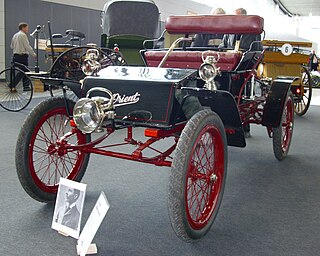
Waltham Manufacturing Company (WMC) was a manufacturer of bicycles, motorcycles, motorized tricycles and quadricycles, buckboards, and automobiles in Waltham, Massachusetts. It sold products under the brand names Orient, Waltham, and Waltham-Orient. The company was founded in 1893, moving to self-propelled vehicles after 1898.
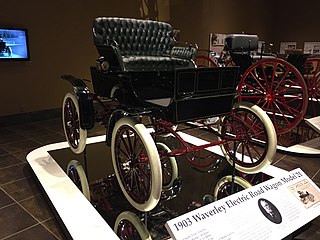
Pope-Waverley was one of the brands of the Pope Motor Car Company founded by Albert Augustus Pope and was a manufacturer of Brass Era electric automobiles in Indianapolis, Indiana. The company was originally formed as the Indiana Bicycle Company in 1898 changing to the American Bicycle Company in 1900. In 1903 it became the International Motor Car Company before joining the Pope group in 1903. From 1908 until production ceased in 1914 they became independent again as the Waverley Company.
St. Louis Motor Carriage Company was a manufacturer of automobiles at 1211–13 North Vandeventer Avenue in St. Louis, Missouri, founded by George Preston Dorris and John French in 1898, with French taking charge of marketing and Dorris heading engineering and production. St. Louis Motor Carriage was the first of many St. Louis automakers and produced automobiles from 1899 to 1907.

The first Cadillac automobiles were the 1903 Model built in the last quarter of 1902. These were 2-seater "horseless carriages" powered by a reliable and sturdy 10 hp (7 kW) single-cylinder engine developed by Henry Martyn Leland and built by Leland and Faulconer Manufacturing Company of Detroit, of which Henry Leland was founder, vice-president and general manager.

Columbia was an American brand of automobiles produced by a group of companies in the United States. They included the Pope Manufacturing Company of Hartford, Connecticut, the Electric Vehicle Company, and an entity of brief existence in 1899, the Columbia Automobile Company.
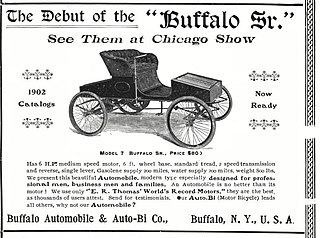
The Buffalo was a United States automobile manufactured from 1900 until 1902, by the Buffalo Automobile and Auto-Bi Company of Buffalo, New York.

The Lambert automobile and Lambert truck were vehicles built from 1905 through 1916 by the Lambert Automobile Company in Anderson, Indiana, United States. The Lambert automobile was an outgrowth from the Union automobile made by the Union Automobile Company, a previous vehicle that was being manufactured by John William Lambert. The factory manufactured about 3,000 automobiles and trucks by 1915 and had several models ranging in price from $1,200 to $3,000 at the time. The vehicles came with a gearless friction drive transmission. The demise of the manufacture of automobiles and trucks came about because of World War I.

The Gladiator Cycle Company, Clément-Gladiator, was a French manufacturer of bicycles, motorcycles and cars based in Le Pré-Saint-Gervais, Seine.

The Cole Motor Car Company was an early automobile maker based in Indianapolis, Indiana. Cole automobiles were built from 1908 until 1925. They were quality-built luxury cars. The make is a pioneer of the V-8 engine.

The Cunningham automobile was a pioneering American production automobile, one of the earliest vehicles in the advent of the automotive age. It was produced from 1896 to 1931 in Rochester, New York by James Cunningham, Son and Company.

The Auto-Bi was an early motorcycle made by the Thomas Motor Company in Buffalo, New York. According to many sources, it was the first motorcycle widely available for sale in the United States.

Malicet & Blin (M.A.B.) was a French manufacturer of bicycles, automobiles, auto components, and aeronautical engines from 1890 until 1925. It expanded into the motor industry in 1897 and aero engines in 1914. They produced both incomplete and entire cars for the UK market, which were badged as Marlborough.

William Chadeayne was an early long-distance motorcyclist from Buffalo, New York. He set a transcontinental record for North America in 1905, going from New York City to San Francisco in 47 and a half days. He was an officer of the Thomas Auto-Bi company and rode one of their motorcycles on the transcontinental record-setting trip.
